Laptop Mag Verdict
This touch-enabled business notebook performs well, but it carries a hefty premium.
Pros
- +
Blazing fast performance
- +
Best-in-class keyboard
- +
Intuitive Simple Tap interface
Cons
- -
Heavier than original T400s
- -
High premium for touchscreen
Why you can trust Laptop Mag
Editors' Note: Portions of this review were taken from our original Lenovo ThinkPad T400s review; the two systems are identical, save for the added touchscreen and Windows 7 OS (instead of Vista) installed on the newer system.
Back in June, Lenovo introduced the svelte, sexy ThinkPad T400s, a notebook we rightly flagged as the best 14-inch business notebook we'd ever tested. It had the best keyboard we'd typed on, incredible CPU performance, a durable but slim sub-4-pound chassis, and the high-end configuration we reviewed even came equipped with a blazing fast 128GB SSD. Now, Lenovo has seemingly upped the ante by adding an optional capacitive touchscreen, which makes the T400s one of the first laptops we've seen that has touch but not the ability to rotate its screen into tablet mode. The touchscreen responds well to gestures, and Lenovo's SimpleTap software works well, but asking users to pay $400 extra to reach past the keyboard and tap the display--and carry a heavier and thicker design--may be too much.
Design
The T400s' matte black chassis, green indicator lights, and bright red trackpoint are similar to those found on every ThinkPad since 1992, but the slim lines and carbon-glass fiber lid are reminiscent of the sleek X300 series. And, identical to the X300 series, the T400s' battery attaches to and sits flush with the bottom of the system, rather than sticking out of its back. As with the X300 series, the T400s' chassis feels extremely firm and durable. Solid contact bumpers on the lid help protect against bumps and drops. Tight metal hinges give the lid a more solid feel than other notebooks. A magnesium alloy keyboard bezel and bottom cover add to the system's strength.
While the original T400s was one of the thinnest and lightest 14-inch systems of all time, the touchscreen adds significant heft to what is still a svelte frame. While the original T400s was 3.9 pounds and 0.8 inches thick, the T400s with touchscreen is 4.4 pounds and 1.4-inches thick.
Touchscreen Performance
The T400s uses a high-quality capacitive digitizer to enable touch, which is similar to those used on the HP TouchSmart tx2z and Dell Latitude XT2. The screen registers contact from several fingers at once, allowing users to perform multitouch gestures such as pinching to zoom or swiping two fingers to scroll.
In testing, the screen was highly responsive, and only a light touch was required for it to register. However, we had to be careful to use the pads at the end of our fingers, as the screen did not always recognize presses with our nails.
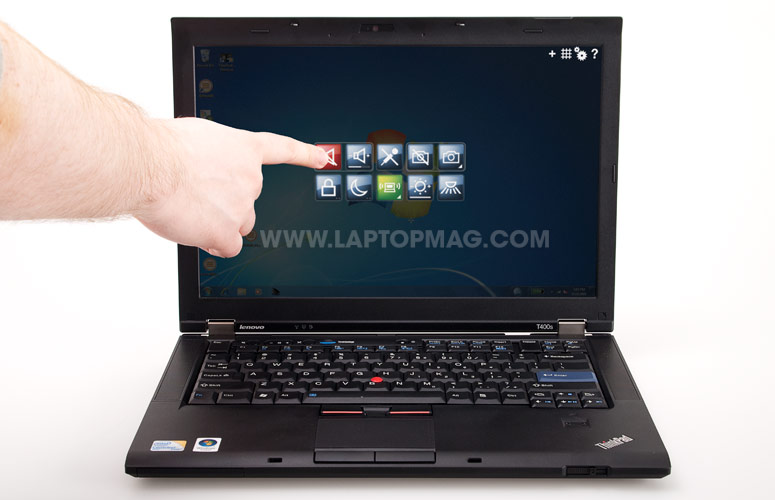
Click to enlargeUsing the tips of our fingers, we were able to take advantage of Windows 7's built-in touch features, including opening Jump Lists by swiping upward on taskbar icons, scrolling in Internet Explorer by swiping up or down, rotating pictures by turning our fingers, and zooming in/out on images and Web pages by pinching.
Despite these built-in Windows features, we found ourselves wishing that either Microsoft or Lenovo had done something about the size of the operating system's widgets and buttons, and how difficult they are to target. Program shortcuts in the Start Menu, which are easy to navigate with a mouse or touchpad, are too small to press accurately with a finger, as are toolbar menus, and the close/minimize/maximize widgets that appear in the upper right corner of every window. It would be easier if all of these elements enlarged as the digitizer detected a finger.
Of course, any Windows 7 application, even those written with no touch support, can accept touches in lieu of mouse gestures. So, for example, we were able to navigate a DVD menu both in Windows Media Player and InterVideo WinDVD using touch, though the buttons were hard to target. Windows Paint is one application that works very well with multitouch, as it allows you to draw with several fingers at once.
Touch Applications
In addition to Windows 7's built-in touch functions, Lenovo included its SimpleTap utility, which is designed to give users touch access to many of the ThinkVantage utilities. Tapping two fingers on the desktop or one finger on a launch icon (a red ball that hangs off the top of the desktop) brings up the interface, which has tiles for brightness control, camera control, the keyboard light, locking the system, microphone on/off, sleep, volume control, and Wi-Fi on/off.
You can add custom tiles for any application, making the SimpleTap desktop a potential Start Menu substitute. We also like that you can add shortcuts to your favorite sites as tiles (SimpleTap automatically pulled in Laptopmag.com's logo for the tile). In addition to tapping the tiles to launch each associated application, you can move them around the screen. When dragged, tiles even bounce off the edges of the display, a neat but impractical special effect.
Our system also came with Windows 7 Touch Pack preinstalled, which includes a few touch games (Microsoft Blackboard, Microsoft Garden, and Microsoft Rebound), a touchscreen saver called Microsoft Surface Lagoon, and Microsoft Surface Collage, a gallery program. While none of these apps are particularly useful, they are great demonstrations of what multitouch can do; we enjoyed being able to make puddles in the screen saver's water by tapping the screen.
Aside from using SimpleTap, taking advantage of Windows 7's built-in touch features, or using it on touch-unaware programs like Word, you're left to download and install your own touch-friendly apps. Unfortunately, there aren't many killer touch apps for Windows right now, unless you're in a niche market that involves 3D modeling or medical imaging. If you are, then you'll appreciate the ability to run programs such as SpaceClaim, a multitouch modeling program that Lenovo points to as an example of the capabilities of the platform.
If you want to use multitouch to help with creating documents in Word, presentations in PowerPoint, images in Photoshop, or videos, you're going to have to keep waiting for their publishers to include touch-friendly features.
Keyboard and Touchpad
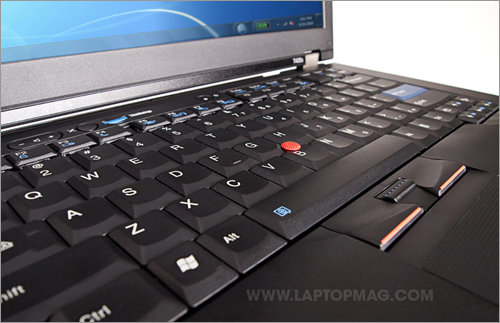
Click to enlarge
On the surface, it seems as though Lenovo made only minor tweaks to its industry-best keyboard design, adding larger Escape and Delete keys, and reducing the empty spaces between keys to prevent crumbs and dust from falling into them. On the Ten Thumbs Typing Test, we achieved a high 84 words per minute--5 percent faster than our 80-word average. But a typing test score alone doesn't take comfort into account; keyboard aficionados will also notice the unmistakable lack of flex, and the strongest feedback ever encountered in a notebook keyboard.
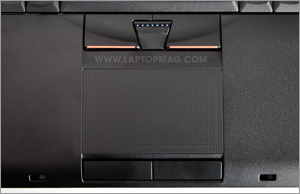
Click to enlargeWe've always liked the accuracy offered by Lenovo's trackpoints, and this machine's is no different. Those who prefer a touchpad, however, will be pleasantly surprised by the wide and accurate textured surface on the T400s's pad. The new touchpad also supports multitouch gestures: A two-finger pinch let us zoom in and out on Web pages and photographs; using our fingers while browsing photos in Windows Picture Viewer allowed us to rotate the images; sliding two fingers up or down in Internet Explorer enables scrolling.
Display and Audio
The 14.1-inch LED-backlit screen provides a native resolution of 1440 x 900, which is the same as the 13.3-inch ThinkPad X300 Series. However, the latter's screens are a little small for that much real estate, so the additional 0.8 inches of panel on the T400s make it much easier on the eyes.
While the screen is bright and images are sharp, viewing angles leave something to be desired. At 45 degrees on either side, the colors wash out significantly. If you're planning a presentation, you'll surely want to use an external monitor or projector. The screen also has a tendency to pick up fingerprints. You won't notice them while the system is on under most circumstances, but if screen brightness is low or you look at it from angle, they are a bit of an eye sore.
Also, DVD playback was lacking. While watching Dark City, we noticed quite a bit of pixilation in all scenes, and visual noise in night scenes. Still, quality should be acceptable for business travelers. Our test system came with a standard DVD burner, but the T400s can be configured with a Blu-ray drive for $560.
When listening to music, the sound from the stereo speakers was clear and distortion-free, though not very loud, even at maximum volume. Sound from videos, including DVD movies, was also clear (though quiet). We recommend turning up the volume to full blast if you're sitting more than a few inches away.
Ports and Webcam
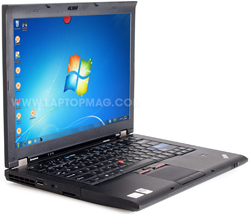
Click to enlarge
The T400s packs plenty of ports into its compact frame. For video connectivity, it has both VGA and DisplayPort. For peripherals, it offers two USB, one eSATA/USB port, an optional 5-in-1 memory card reader (which was present on our test unit), Ethernet, and a combined microphone/audio-out port.
An ExpressCard/34 slot is available as a $10 option (our test system didn't have one). When you consider that even $350 netbooks have card readers, it seems odd that Lenovo didn't make one standard on its pricey T400s.
The integrated 2.0-megapixel webcam provided clear, sharp images on a Skype call from our office, which has good overhead lighting. When performing the same test in a dim bedroom with just one table lamp for light, the webcam still produced a sharp image, albeit with some noise.
Heat
Many thin-and-light notebooks do a poor job of dissipating heat. The ThinkPad T400s manages to stay cool, however, registering low temperatures even when performing CPU-intensive tasks. While transcoding a video, the T400s measured a temperate 85.5 degrees Fahrenheit between its G and H keys. The touchpad and bottom back were both practically chilly at 80.5 and 88.0 degrees, respectively.
Performance
The T400s' 2.53-GHz Core 2 Duo P9600 CPU and speedy solid state drive allowed this notebook to turn in incredibly strong benchmark scores. Unfortunately, PCMark Vantage, which measures overall system performance, would not run under Windows 7 Professional. However, when we tested a similarly configured T400s in June using Windows Vista, the system scored 5,893, which was the highest we'd ever seen on any laptop we've tested, and almost 3,000 points above the category average for thin-and-light notebooks (those with 12- to 14-inch screens that weigh less than 6 pounds). That score was also more than 50 percent greater than the ones received by the original T400 (3,576) and such 14-inch business notebooks as the HP EliteBook 6930p (3,749) and Toshiba Tecra R10 (3,490).
The T400s completed our video transcoding test, in which we convert a 5-minute-and-5-second MPEG-4 to AVI using HandBrake, in a speedy 6:31, more than 20 seconds faster than the category average (6:57). Its time was a bit slower than the original T400s (6:10), but we can only chalk that up to differences in the operating system or an element of randomness in the test, as they share the same hardware.
The lightning-fast Toshiba SSD booted Windows 7 Professional in just 46 seconds, and completed our LAPTOP Transfer Test, in which we copy 4.97GB of mixed-media files from one folder to another, in just 66 seconds--a rate of 77.1 MBps. That's the fastest score achieved on any notebook we've tested. That's nearly four times the category average (19.6 MBps), and is a little faster than what we got with the original T400s under Vista (66.0 MBps).
Graphics
Like the original T400s, the touchscreen version didn't score well on 3DMark06, which measures graphics performance. The notebook's integrated Intel GMA X4500 graphics chip produced a weak score of 1,120, which is well below the category average (1,479), and far behind the HP EliteBook 6930p (1,792) and Toshiba Tecra R10 (1,643). The ThinkPad T400 we tested back in December 2008 had switchable graphics, and scored just 753 in integrated graphics mode, but a much higher 2,557 in discrete graphics mode.
The original T400s, which has the same graphics chip, scored only 989 in Vista, so Windows 7 must be pushing the score a little higher on our new review unit. This is also true of our Far Cry 2 test, as the new T400s got 14.7 frames per second in 1024 x 768-pixel resolution, while the original T400s managed only 6 fps. Still, we wouldn't recommend playing games on this system.
Battery Life and Wi-Fi
On the LAPTOP Battery Test, which involves continuous Web surfing over Wi-Fi, the T400s lasted a disappointing 3 hours and 56 minutes, which is 30 minutes less than the non-touchscreen T400s (4:26). This is also 18 minutes less than the category average for thin-and-light notebooks, and quite a bit less than the 4:23 provided by the Toshiba Tecra R10.
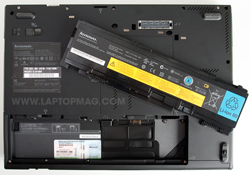
Click to enlargeLenovo says that the touchscreen should not lower the battery life by more than a few minutes, so perhaps the 30-minute difference is attributable to Windows 7 drivers (or some other cause). We will retest the touch-enabled T400s, and update this review with the results.
Lenovo doesn't make an extended battery for the T400s. A three-cell bay battery, however, which can be swapped into the optical drive bay, will be available for $119, and promises an additional 2 to 3 hours of endurance.
The ThinkPad T400s's Intel WiFi Link 5100AGN wireless card delivered strong transfer rates of 20.8 Mbps from 15 feet and 17.1 Mbps from 50 feet, each above the category averages of 19.6 and 15.5 Mbps, respectively. The T400s we reviewed in June had a more expensive WiFi Link 5300 card, which produced a slightly higher score of 19.2 Mbps from 50 feet.
Green Testing
It took 2 hours and 19 minutes to charge the T400s up to 100 percent, and the system used an average of 41.5 watts during that time. The notebook's LAPTOP Battery Efficiency Rating (the total amount of watts it takes to recharge divided by the battery life) was 24.4, about 4 watts more efficient than the category average of 28.7 (lower is better). The T400s is also a fairly green unit by EPEAT's measure, getting a Gold rating of 21 (out of 27) on that organization's tests.
Configuration and Upgrade Options
Our configuration of the T400s costs $2,479, but the ThinkPad T400s starts at $1,999 with fewer features. The touchscreen itself is a $400 premium over an identically configured T400s without touch.
Some other options to consider are integrated mobile broadband ($80 for AT&T or $125 for Verizon Wireless), and the $119 UltraBay battery, which promises to increase the system's endurance by 50 percent. The 5-in-1 memory card reader can be swapped for an ExpressCard/34 slot.
Both the RAM and the hard drive on the T400s are user-accessible. The two RAM slots are located behind an upgrade panel, and can hold up to 8GB of DDR3 RAM. For storage, the system has one 1.8-inch SATA drive, which slides out from a compartment near the battery. While 1.8-inch hard drives and SSDs can be found on the aftermarket, they are much harder to find and are more expensive than their 2.5-inch counterparts.
Software and Warranty
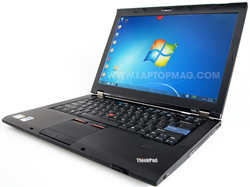
Click to enlarge
The T400s comes with the standard suite of Lenovo ThinkVantage utilities updated for Windows 7, including backup, connection, password manager, and power management applications. InterVideo WinDVD 8 is preinstalled for watching DVDs, and the system comes with a Trusted Platform Module (TPM) chip to help protect your data.
Lenovo backs the T400s with a standard one-year warranty on parts and labor; you can, however, purchase up to three years of warranty protection, and add such extras as same-day service.
To see how Lenovo fared on LAPTOP's Tech Support Showdown, click here.
Verdict
The Lenovo ThinkPad T400s with touch packs the same groundbreaking performance as its nontouch sibling, and combines a responsive capacitive screen with simple but effective touch software. That said, we don't think the significant increase in bulk and price are worth it for the average business user. If you plan to use a touch-specific app like SpaceClaim, it might make sense to pay the $400 premium and learn to live with the added weight and thickness. However, if you mostly use your notebook for Office apps and the Web, you're better off with the original ThinkPad T400s.
Lenovo ThinkPad T400s (Touch) Specs
| Bluetooth | Bluetooth 2.0 |
| Brand | Lenovo |
| CPU | Core 2 Duo P9600 2.53Ghz |
| Card Slots | 5-1 card reader |
| Company Website | www.lenovo.com |
| Display Size | 14.1 |
| Graphics Card | Graphics Card Intel GMA 4500MHD |
| Hard Drive Size | 128GB |
| Hard Drive Type | SSD Drive |
| Native Resolution | 1440x900 |
| Operating System | Windows 7 Professional (32-bit) |
| Optical Drive | DVDRW SuperDrive |
| Optical Drive Speed | 8X |
| Ports (excluding USB) | Microphone, Headphone, Ethernet, DisplayPort, VGA, USB/eSATA |
| RAM | 4GB |
| RAM Upgradable to | 8GB |
| Size | 13.3 x 9.5 x 1.4 inches |
| USB Ports | 2 |
| Video Memory | 32MB |
| Warranty/Support | One-year parts-and-labor/24/7 toll-free phone |
| Weight | 4.4 pounds |
| Wi-Fi | 802.11a/g/n |

